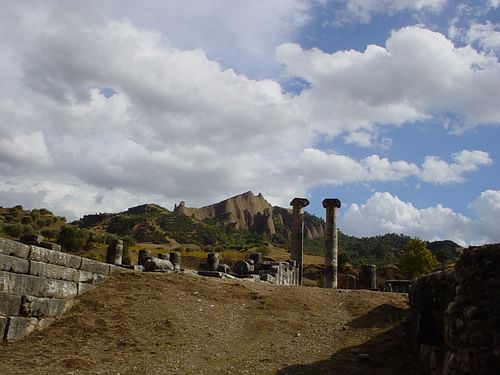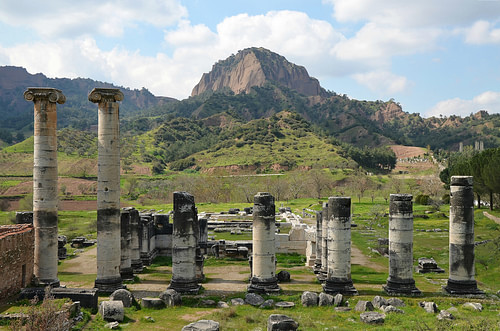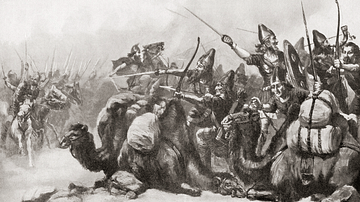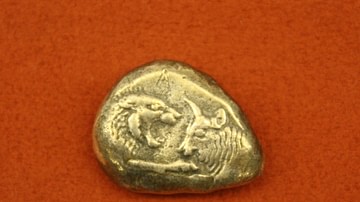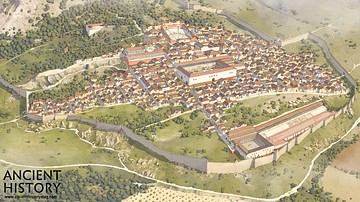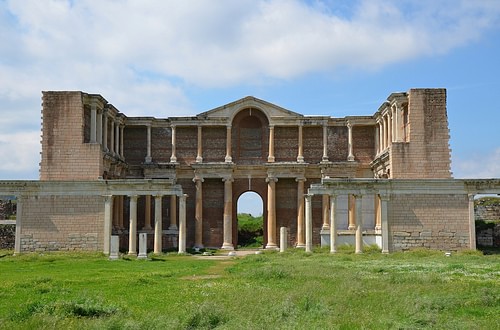
Sardis (near modern-day Sart, Turkey) was the capital of the ancient Kingdom of Lydia founded (according to Herodotus) by the Heracleidae, the Heraclid Dynasty descended from the hero Heracles (Hercules). The city was famous in antiquity for its wealth, culture, and favorable position on the central trade route from the Aegean Sea to the interior of Asia Minor.
According to Herodotus (l. c. 484-425/413 BCE), Lydia was established by one Lydus, son of Atys, and was then given to the Heracleidae, who held it for 505 years until the last king, Candaules, was assassinated by Gyges, who established the Mermnad Dynasty that ended with Croesus (r. 560-546 BCE) when Sardis was taken by the Persian Achaemenid Empire under Cyrus II (also known as Cyrus the Great, r. c. 550-530 BCE) in 547/546 BCE.
The Persians held it until the conquest of Alexander the Great in 334 BCE, and after his death, it became part of the Seleucid Empire (312-63 BCE) before it was absorbed into Rome as an important trade city in the Roman province of Asia. Sardis was sacked by the Sasanian Persian Empire and severely damaged in the 7th century by which time it had long become associated with Christianity as one of the Seven Churches of Asia mentioned in the biblical Book of Revelation. It continued as an important religious, intellectual, cultural, and trade center until the early 15th century when it was abandoned.
From its early foundation to its fall, Sardis is associated with several noteworthy people and events including but not limited to:
- the first city in the world to mint coins under King Alyattes (r. c. 635-585 BCE)
- capital of the Kingdom of Lydia and home to Croesus, who is considered the richest man of his time
- the western terminus of administrative trade of the Achaemenid Empire (c. 550-330 BCE)
- site of the launch of Xerxes I's 480 BCE invasion of Greece
- site of the muster of the Greek mercenaries in 401 BCE described by Xenophon in his Anabasis
- site of the Siege of Sardis (215-213 BCE) led by Antiochus III of the Seleucid Empire
- site of the Temple of Artemis, the fourth largest Ionic temple in the world (c. 300 BCE)
- one of the greatest metropolises of Asia Minor; Carian, Greek, Hebrew, Latin, Lydian, and other languages appear on inscriptions there through the late Roman period
- site of the largest synagogue in Asia Minor
- home of Melito of Sardis (d. c. 180 BCE), bishop and Christian apologist
- one of the Seven Churches of Asia addressed in the Book of Revelation
- site of the cemetery of Bin Tepe dated from Lydia to the Ottoman period
One of the most often referenced features of Sardis is its citadel which modern-day writers regularly describe, citing the historian Polybius, as "the strongest place in the world." Polybius' line, however, is actually ironic in context and has to do with the capture of Achaeus (d. 213 BCE), lord of Sardis, by Antiochus III (the Great, r. 223-187 BCE). Polybius (l. c. 200 to c. 118 BCE) observes how, after Achaeus was secretly tricked into leaving the citadel and captured, his people, knowing nothing of his abduction, thought him safe in "the strongest place in the world" (8.20.12); he is not saying it actually was so.
The city was rediscovered by Howard Crosby Butler of Princeton University between 1910 and 1914, but work was halted by World War I and further hostilities in the region. Although excavations continued at the site in the 1920s, the next major expedition was in 1958 by George M. A. Hanfmann of Harvard University with work continuing up to the present day and now supervised by Dr. Nicholas Cahill of the University of Wisconsin-Madison.
Early History & Location
Sardis was located near the Hermus River (modern-day Gediz River) at the base of Mount Tmolus, named for the mythical Lydian king who, according to legend, was gored to death there by a bull as punishment for offending the gods. His widow, Omphale (according to Diodorus Siculus), established the Heraclid Dynasty, while, according to Herodotus, it was King Agron (though this has been challenged). Herodotus claims the Heracleidae's ancestors were "Heracles and a slave girl" (Book I.7) but may be confusing Omphale, who held Heracles as a slave for a year, with the Omphale of Tmolus. It is also possible, the woman in the two stories is the same mythical character.
Herodotus relates how the Heracleidae ruled for 505 years until King Candaules was assassinated by his bodyguard, Gyges, who then married Candaules' widow and founded the Mermnad Dynasty. His successors fought the Cimmerians of the north, who repeatedly raided the kingdom until King Alyattes, allied with the Scythians, defeated them and stabilized the kingdom. Alyattes was the first monarch in the world to mint coins (made from electrum) while his son and successor, Croesus, would be the first to mint them of gold.
Croesus' wealth was said to derive from the River Pactolus where, according to legend, King Midas of the golden touch had washed his hands to free himself of the 'gift' of having everything he touched turn to gold. In doing so, he made the riverbed rich with gold deposits. The gold of the river was actually carried down from deposits in Mount Tmolus, and this, combined with the fertility of the Hermus Valley, made Sardis a wealthy city. Coins minted in Sardis were of such purity that they were accepted in trade by everyone, further enriching Sardis and its king.
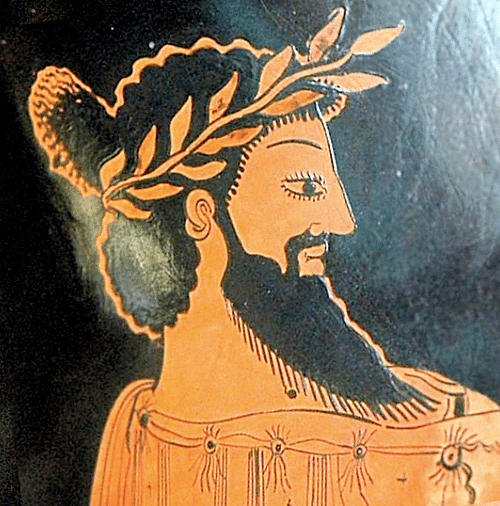
Croesus subdued the Ionian and Aeolian cities, allied himself with island city-states, and continued his military campaigns to establish the Kingdom of Lydia with Mysia to the north, Phrygia to the east, and Caria to the south. Tribute from the conquered cities and trade with others continued to enrich the city, and its location in a fertile valley along the central route from the Aegean Sea to the interior of Asia Minor (Anatolia) elevated the city's status further. The acropolis and citadel on the Tmolus range high above the city also made it easily defensible, and Croesus, the richest king in the region, had every reason to believe he was invincible and could do whatever he pleased.
Persia & Alexander
Croesus recognized a successful campaign against the growing empire of Cyrus II of Persia could only enrich him further and so sent emissaries to the Oracle at Delphi seeking assurance. The Oracle returned the message, "If Croesus goes to war, he will destroy a great kingdom" (Herodotus, Book I. 53). Croesus, thinking the prediction assured his victory, was delighted at this news, launched his attack, and was defeated at the Battle of Thymbra in 547 BCE. Having retreated back to Sardis after the Battle of Pteria (547 BCE), which was a draw between Croesus and Cyrus II, he demobilized his troops for the winter, expecting Cyrus II to do the same in keeping with custom.
Cyrus II, however, pursued him, defeated him at the Battle of Thymbra outside of Sardis, and after a 14-day siege, the city fell. The 'great kingdom' that was destroyed turned out to be his own. Herodotus, the historian Ctesias (l. 5th century BCE), and later writers claim that Croesus was rewarded by Cyrus II after explaining how he had misinterpreted the message of the oracle, but most likely he was executed. There is no record of how he died or when, providing ancient historians with the opportunity to give his story a conclusion in keeping with his successful reign.
Cyrus II incorporated Lydia into his Achaemenid Empire, and owing to its location, it became one of the most important satrapies in administering the western regions of Persia's territory and conducting trade. Under Darius I (The Great, r. 522-486 BCE), the Royal Road ran from Susa, one of the empire's capitals, directly to Sardis. During the Ionian Revolt (499-493 BCE), when Ionian Greeks rebelled against Persian rule, an Athenian-led force burned Sardis in 498 BCE, enraging Darius I so greatly that he swore revenge on Athens, leading to the First Persian Invasion of Greece in 490 BCE, famously broken at the Battle of Marathon in a Greek victory.
Darius I's successor, Xerxes I (r. 486-465 BCE), tried to avenge this defeat and mobilized his vast army at Sardis in 480 BCE for his own invasion of Greece which was also driven back. Sardis played a pivotal role in another invasion in 401 BCE when it served as the launch site of the army of Cyrus the Younger (d. 401 BCE) against his brother Artaxerxes II (r. 404-358 BCE) for control of the empire. Cyrus the Younger enlisted the Ten Thousand Greek mercenaries made famous by the Anabasis of Xenophon (l. 430 to c. 354 BCE) but was killed at the Battle of Cunaxa in 401 BCE, leaving Xenophon, as one of the commanders, to lead his men back home to Greece – the journey given in the Anabasis.
Sardis continued as an important satrapy of the empire through the reign of Darius III (336-330 BCE), who was defeated by Alexander the Great, ending the Achaemenid Empire. Sardis maintained its position as an important trade and administration center during Alexander's time and, after his death in 323 BCE, his general Seleucus I Nicator (r. 305-281 BCE) held the city as part of his Seleucid Empire. Seleucus I continued the administrative and political policies of the Persians and so Sardis retained its stature during and after his reign. The great Temple of Artemis is thought to have been conceived and started during this period (c. 300 BCE) but was still unfinished by the 4th century CE.
Seleucid Empire
The Seleucid Empire maintained control of its vast territories until 247 BCE when Arsaces I of Parthia (r. 247-217 BCE) broke away and formed the independent state which would become the center of the Parthian Empire. Other regions followed suit and the Seleucid monarchs struggled to maintain control while, at the same time, Carthage, the Mediterranean naval superpower, came into conflict with the small city-state of Rome. Rome quickly learned the necessary skills for naval warfare, defeated Carthage in the First Punic War (264-241 BCE), and became the new master of the Mediterranean.
The Seleucid kings continued their struggles until Antiochus III came to power in 223 BCE and led his troops on campaign to bring rebellious regions back in line. He appointed his cousin, Achaeus, commander of the army west of the Taurus Mountains as Achaeus had proven himself loyal to the king in the past. When Achaeus was falsely accused of inciting insurrection, however, he declared himself king and established himself at Sardis with his queen, Laodice of Pontus. Antiochus III arrived and placed Sardis under siege, but Achaeus, his wife, and chief counselors remained out of reach in the high citadel above the city.
According to Polybius, the siege was steadily draining the city's resources and so an admirer of Achaeus devised a plan to sneak him out so he could rally troops and lift the siege. A Cretan named Bolis, who knew the area, was hired for the job, but after convincing Achaeus of his sincere intention to lead him to safety, betrayed him to Antiochus III who executed him. This event has given rise to one of the most frequently repeated lines on Sardis as "the strongest place in the world," but Polybius is remarking ironically. No one was aware at the time that Achaeus had been taken, and so Polybius writes:
And now, when he was supposed by his own forces and those of the enemy to be dwelling secure in the strongest place in the world, he was actually sitting on the ground bound hand and foot and at the mercy of his enemies, not a soul being aware of what had happened except the actual perpetrators of the deed. (Histories, 8.20.12)
Polybius never says Sardis or its citadel was "the strongest place in the world," only that it was thought so, and, clearly, it was not safe enough to keep Achaeus from falling into enemy hands. After word of her husband's death reached Laodice, she surrendered the city to Antiochus III.
Under Rome
When Antiochus III took Sardis in 213 BCE, Rome was again engaged in conflict with Carthage in the Second Punic War (218-202 BCE), and when Carthage was defeated, its general, Hannibal Barca (l. 247-183 BCE) fled to his court. Hannibal counseled the king against Rome and encouraged him to strike first before the Romans could unseat him. Antiochus III marched against Rome and was defeated at the Battle of Magnesia in 190 BCE. Afterwards, he was forced to sign the Treaty of Apamea of 188 BCE, forcing him to withdraw from Anatolia and handing Sardis over to the Attalid Dynasty of Pergamon, Rome's allies. The Standing Committee on Archaeology of Harvard University, in discussing their 2014 conference on Sardis, observes:
The traditional understanding of Antiochus III's siege of Sardis in 215-213 BCE as the great rupture in the city's history can no longer be sustained. Instead, it seems that the city's fortunes turned with the Peace of Apamea in 188 BCE, after which Sardis was incorporated into the newly expanded Attalid empire. Shortly thereafter, the city's elites introduced new cults and festivals, a new stone theater was constructed, dedications were re-inscribed in the Artemis sanctuary, a political culture of honorific statuary developed, and Pergamene-inspired household goods were produced for a burgeoning middle class. (2)
Sardis continued to flourish under the Attalid Dynasty until it was ceded to Rome, along with the rest of the Kingdom of Pergamon, by the last king Attalus III (r. 138-133 BCE) in 133 BCE. The former Kingdom of Pergamon became Rome's Asian province, and Sardis now played the same role it always had in administration, trade, and culture but, by this time, was far more cosmopolitan than it had been in the days of Croesus, attracting many different nationalities and religions.
The city continued to thrive until it was destroyed in an earthquake in 17 CE but was rebuilt by funds supplied by Roman emperor Tiberius (r. 14-37 CE). A church is thought to have been established in the city at some point prior to the commonly accepted date for the composition of the Book of Revelation (c. 95 CE), which warns the congregation against maintaining an appearance of piety and devotion while straying from true commitment to God:
To the angel of the church in Sardis, write: These are the words of him who holds the seven spirits of God and the seven stars. I know your deeds; you have a reputation of being alive, but you are dead. (3:1)
There is no archaeological evidence of a church in Sardis prior to c. 95 CE, but as only a small part of the vast city has been excavated, this may come to light in the future. The Temple of Artemis remained unfinished in the 4th century CE and was abandoned by the time a small church was built at its southeast corner (Cahill, 3). This church building, however, is not believed to be the church addressed in Revelation.
Later emperors also admired the city, including Trajan (r. 98-117 CE) and Hadrian (r. 117-138 CE). The Christian apologist and bishop, Melito of Sardis, wrote to Marcus Aurelius (r. 161-180 CE) from the city, explaining Christianity and asking him to end the persecutions that were encouraging daily violence against the Christians of Sardis and elsewhere. Melito addresses Aurelius as a protector and it is thought the persecutions were encouraged by regional governors, not by the emperor. Either way, Melito's arguments were ignored and persecutions continued under Diocletian (r. 284-305 CE), who, at the same time, granted Sardis the honorary title of metropolis.
Conclusion
The cosmopolitan nature of Sardis in the 3rd century CE is evidenced not only in writing but also by the archaeological evidence, which includes the largest synagogue in Asia Minor dating from that period. In 330 CE, when Byzantium became Constantinople and was the new capital of the Eastern Roman Empire, Sardis was sidelined by the new system of roads and, for the first time in its history, lost its prestige. It was sacked in 615 CE by the Sasanian Empire under Kosrau II (r. 590-628 CE) and the extensive damage was never repaired, since, at this time, Rome could not afford the expense.
The city continued as an important cultural center as evidenced by the tumuli of Bin Tepe, an ancient cemetery covering 45 square miles (116 square km) and dating from the Kingdom of Lydia through the Hellenistic, Roman, and into the Ottoman periods. The Ottoman Turks first took Sardis in the 11th century, and it began to decline until it was abandoned and possibly destroyed around 1402.
The ruins of Sardis became steadily overgrown, and stones from the buildings and temples were removed over the years by locals for other purposes. British explorers removed statuary and other artifacts in the 19th century, but no formal excavation of the site was attempted until 1910-1914 by Howard Crosby Butler of Princeton University. Excavations continue at the site in the present day under the supervision of Dr. Nicholas Cahill of the University of Wisconsin-Madison, bringing to light one of the greatest cities of the ancient world whose history spanned over 2,000 years.

